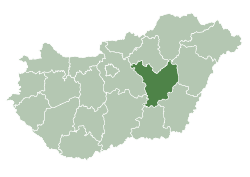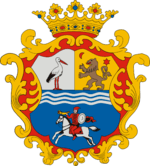Jánoshida
| Jánoshida | ||
|---|---|---|
| Village | ||
| ||
 Jánoshida | ||
| Coordinates: 47°23′11″N 20°03′29″E / 47.38639°N 20.05806°ECoordinates: 47°23′11″N 20°03′29″E / 47.38639°N 20.05806°E | ||
| Country |
| |
| County | Jász-Nagykun-Szolnok | |
| District | Jászapáti | |
| Area | ||
| • Total | 34.79 km2 (13.43 sq mi) | |
| Population (2015) | ||
| • Total | 2,394[1] | |
| • Density | 78.33/km2 (202.9/sq mi) | |
| Time zone | UTC+1 (CET) | |
| • Summer (DST) | UTC+2 (CEST) | |
| Postal code | 5143 | |
| Area code(s) | (+36) 57 | |
Jánoshida is a village in Jász-Nagykun-Szolnok county, in the Northern Great Plain region of central Hungary.

It covers an area of 34.79 km2 (13 sq mi) and has a population of 2394 people (2015).[1]
History
The earliest signs are from archaeologic finds of Bronze Age (1800-1700 BC). An Avarian flute was found from c. 6-7 AD. In 1186 Béla III of Hungary donated the village to the premontre priests and they built a monastery. The romanesque style of the monastery resembles to those of bishop of Vác, or archbishop of Esztergom. The patrocinium of the monastery was John the Baptist. The name of the village had been at that time Szentkereszt (The Holy Cross), and later has got the name of Jánoshida (The bridge of John). The monastery was the centre of the provostry. In 1536 the village and the monastery was destroyed in the Turkish wars. Only after 1688, the year of liberation from the Turkish occupation could the village and monastery have benn rebuilt. In 1715 the village belonged to Pest County. The church have been rebuilt in barock style. The monastery has got classicist style facade in 1830. In 1854 Jánoshida has been moved to Heves County. Finally, in 1876 it was moved to Jász-Nagykun-Szolnok County.
Sightseeings
The church with details remained and preserved in romanesque style is the most attractive tourist sightseeing in Jánoshida. The southern doorway of the chapel is in romanesque style and the monastery can be also visited.
References
- Gerevich Tibor: Magyarország románkori emlékei, (Romanesque Heritage in Hungary.) Királyi Magyar Egyetemi Nyomda, Budapest, 1938.
- Gerő László (1984): Magyar műemléki ABC. Budapest,
- Henszlmann Imre: Magyarország ó-keresztyén, román és átmeneti stylü mű-emlékeinek rövid ismertetése, Királyi Magyar Egyetemi Nyomda, Budapest, 1876.
- 1 2 Gazetteer of Hungary, 1st January 2015. Hungarian Central Statistical Office. 03/09/2015
External links
- Official site in Hungarian
- Heritage of Jánoshida


